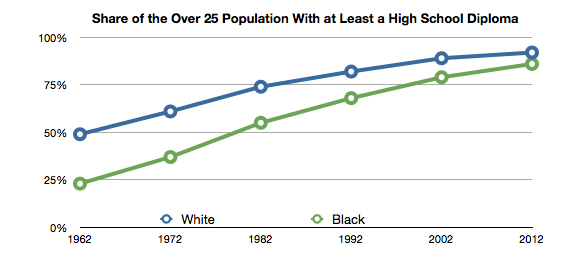Matthew Yglesias
Posted Wednesday, Aug. 28, 2013, at 10:06 AM

Tourists visit the the Martin Luther King Jr. Memorial on Aug. 24, 2013. Can King's dream is being fulfilled in some ways, but not others.
Photo by Pete Marovich/Getty Images
To state the obvious, race relations in America are dramatically different today than they were 50 years ago. And this manifests itself in any number of concrete ways. One particularly dramatic way is the closing of the once-enormous gap in high school graduation rates (data via Pew), which have risen for both whites and blacks while growing more equal:

Unfortunately, the racial gap in median household income remains about as large as ever:

And since wealth is built up multigenerationally over time, the black-white gap in wealth remains absolutely enormous. Many middle-class white families—but very few middle-class black ones—still enjoy some wealth legacy from the New Deal and Fair Deal eras when affirmative action was white. Extensive government programs were created to bolster middle-class wealth and incomes, and black citizens were more or less excluded from participating in them.

Posted Wednesday, Aug. 28, 2013, at 10:06 AM

Tourists visit the the Martin Luther King Jr. Memorial on Aug. 24, 2013. Can King's dream is being fulfilled in some ways, but not others.
Photo by Pete Marovich/Getty Images
To state the obvious, race relations in America are dramatically different today than they were 50 years ago. And this manifests itself in any number of concrete ways. One particularly dramatic way is the closing of the once-enormous gap in high school graduation rates (data via Pew), which have risen for both whites and blacks while growing more equal:

Unfortunately, the racial gap in median household income remains about as large as ever:

And since wealth is built up multigenerationally over time, the black-white gap in wealth remains absolutely enormous. Many middle-class white families—but very few middle-class black ones—still enjoy some wealth legacy from the New Deal and Fair Deal eras when affirmative action was white. Extensive government programs were created to bolster middle-class wealth and incomes, and black citizens were more or less excluded from participating in them.




